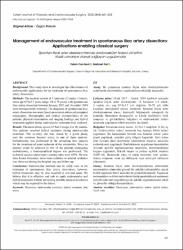| dc.contributor.author | Sevil, Fehim Can | |
| dc.contributor.author | Tort, Mehmet | |
| dc.date.accessioned | 2021-05-05T22:14:06Z | |
| dc.date.available | 2021-05-05T22:14:06Z | |
| dc.date.issued | 2020 | |
| dc.identifier.issn | 1301-5680 | |
| dc.identifier.uri | https://doi.org/10.5606/tgkdc.dergisi.2020.19668 | |
| dc.identifier.uri | https://hdl.handle.net/20.500.12933/288 | |
| dc.description | Sevil, Fehim can/0000-0003-3902-9831 | en_US |
| dc.description | WOS:000582714700005 | en_US |
| dc.description | PubMed: 33403132 | en_US |
| dc.description.abstract | Background: This study aims to investigate the effectiveness of endovascular applications for the treatment of spontaneous iliac artery dissections. Methods: The medical records of 13 patients (12 males, 1 female; mean age 67.9 +/- 5.7 years; range, 58 to 75 years) with spontaneous iliac artery dissection between January 2017 and December 2019 were retrospectively reviewed. The diagnosis of spontaneous iliac artery dissection was made based on contrast-enhanced computed tomography. Demographic and clinical characteristics of the patients, physical examination and imaging findings, and hybrid treatments applied during endovascular treatment were analyzed. Results: The mean follow-up was 12.5 +/- 1.1 (range, 6 to 16) months. Five patients received hybrid treatment during endovascular treatment. The re- entry site was closed by a patch plasty over the common femoral artery in one of these patients. Embolectomy was performed in the remaining four patients for the treatment of acute ischemia of the extremities. Since no patency could be achieved in two of the patients undergoing embolectomy, a femoropopliteal bypass was performed. The technical success and primary patency rates were 100%. No new false lumen formation, intra-stent occlusion or arterial occlusion was observed during the hospital stay and follow-up. Conclusion: Endovascular methods can be safely used in the treatment of spontaneous iliac artery dissections; however, hybrid treatments may be also required in selected cases. We believe that it is effective and safe to apply endovascular and hybrid treatments without preventing possible surgical treatments which may be required in the future. | en_US |
| dc.language.iso | eng | en_US |
| dc.publisher | Baycinar Medical Publ-Baycinar Tibbi Yayincilik | en_US |
| dc.rights | info:eu-repo/semantics/openAccess | en_US |
| dc.subject | Dissection | en_US |
| dc.subject | endovascular treatment | en_US |
| dc.subject | hybrid treatment | en_US |
| dc.subject | iliac artery | en_US |
| dc.title | Management of endovascular treatment in spontaneous iliac artery dissections: Applications enabling classical surgery | en_US |
| dc.type | article | en_US |
| dc.department | AFSÜ, Tıp Fakültesi, Cerrahi Tıp Bilimleri Bölümü, Kalp ve Damar Cerrahisi Ana Bilim Dalı | en_US |
| dc.contributor.institutionauthor | Sevil, Fehim Can | |
| dc.contributor.institutionauthor | Tort, Mehmet | |
| dc.identifier.doi | 10.5606/tgkdc.dergisi.2020.19668 | |
| dc.identifier.volume | 28 | en_US |
| dc.identifier.issue | 4 | en_US |
| dc.identifier.startpage | 601 | en_US |
| dc.identifier.endpage | 608 | en_US |
| dc.relation.journal | Turk Gogus Kalp Damar Cerrahisi Dergisi-Turkish Journal Of Thoracic And Cardiovascular Surgery | en_US |
| dc.relation.publicationcategory | Makale - Uluslararası Hakemli Dergi - Kurum Öğretim Elemanı | en_US |
















